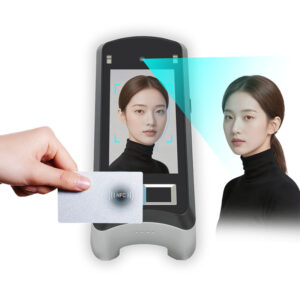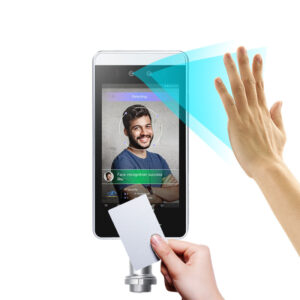What Is NFC Biometric Authentication?
NFC biometric authentication integrates NFC communication technology with biometric data verification to identify and authorize individuals securely. NFC enables short-range wireless communication between devices — typically within a few centimeters — while biometric systems verify a user’s unique biological traits such as fingerprints, facial features, or palm veins.
When combined, these two technologies enable instant and secure identity verification. A user simply taps an NFC-enabled card, smartphone, or wearable device near the reader, and the system cross-verifies their biometric credentials before granting access.
How NFC Biometric Access Control Works
The access control process using NFC biometric technology is more structured than conventional systems. It involves enrollment, credential assignment, and verification:
1. User Enrollment
This biometric template is encrypted and securely stored in the system database.
An NFC credential (card, smartphone, or wearable device) is assigned to the user, linking their physical NFC token with their biometric template.
Some advanced systems allow mobile NFC credentials, where the card information is stored digitally on the user’s smartphone.
2. Registration of NFC Credential
The assigned NFC card or device is registered in the access control system and associated with the individual’s biometric profile.
This step ensures that only the correct combination of NFC credential and biometric data can unlock doors or gates.
Optional features may include time-based access restrictions (e.g., employee schedules) or zone-based permissions (e.g., restricted areas).
3. Authentication & Access Granting
To enter, the user presents their NFC credential to the reader.
The system prompts a biometric scan (fingerprint or facial recognition).
The access control system compares the live biometric scan with the stored template linked to that NFC credential.
If the match is successful, access is granted instantly; otherwise, entry is denied, and security alerts may be triggered.
This method is considered multi-factor authentication because it combines:
Something the user has: the NFC credential
Something the user is: their biometric trait
Advantages of NFC Biometric Access Control
Implementing NFC biometric authentication provides numerous benefits:
1. セキュリティの強化
Traditional ID cards or PIN codes are prone to theft or duplication. NFC biometric systems require the actual user to be present, drastically reducing unauthorized access.
2. Contactless Convenience
Users can access doors or turnstiles without touching shared surfaces, ensuring hygiene and speed—ideal for post-pandemic workplaces.
3. Fast and Reliable Access
With instant NFC communication and biometric recognition, access is granted in seconds, improving workflow efficiency in high-traffic areas.
4. Flexible Access Management
Administrators can assign custom access levels for different employees, visitors, or departments, while monitoring real-time activity logs through integrated access software.
5. Integration with Attendance Systems
Many NFC biometric solutions double as time attendance systems, automatically logging employee work hours, shifts, and entry/exit times.
6. Data Privacy and Encryption
All biometric and NFC data are encrypted during storage and transmission, meeting global privacy regulations such as GDPR.
関連商品
Applications of NFC Biometric Access Control
NFC biometric authentication is widely used across multiple industries:
Corporate Offices: Secure employee entry, manage attendance, and protect sensitive areas.
Government & Military Facilities: Ensure reliable verification for authorized personnel.
Healthcare Institutions: Safeguard patient areas and secure medical records.
Educational Campuses: Control access to dormitories, labs, and research centers.
Smart Residential Complexes: Provide residents with keyless, contactless entry.
Transportation & Logistics: Manage secure access to airports, warehouses, and cargo terminals.
Integration with Other Biometric Technologies
Modern systems often combine NFC authentication with fingerprint scanners, face recognition, or palm vein readers. This multi-modal approach improves accuracy, enhances security, and allows deployment in various environments.
For example, HFSECURITY’s access control solutions combine NFC cards, facial recognition, and fingerprint authentication in one device, enabling fast, contactless, and reliable verification for corporate and public applications.
今後の動向
Emerging technologies are shaping the next generation of NFC biometric access systems:
Mobile NFC Credentials: Users can store access rights on smartphones, eliminating physical cards.
AI-Powered Biometric Verification: Advanced algorithms speed up identification and reduce false rejections.
Cloud-Based Management: Remote monitoring and configuration via secure cloud platforms.
Integration with IoT and Smart Buildings: Seamless operation with connected devices for enhanced security.
Blockchain Security: Immutable, tamper-proof logs of access events.
These innovations indicate a shift toward fully automated, intelligent, and secure access control ecosystems.
結論
NFC biometric authentication in access control systems offers a highly secure, contactless, and user-friendly solution for modern security challenges. By combining NFC credentials with biometric verification, organizations can achieve multi-factor authentication, precise identity verification, and seamless access management.
From corporate offices to smart homes, NFC biometric access control is redefining security, convenience, and efficiency in today’s connected world.
お問い合わせ
ぜひお話させてください。
お気軽に下記までご連絡ください。




